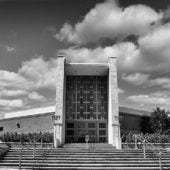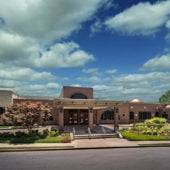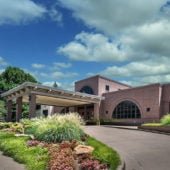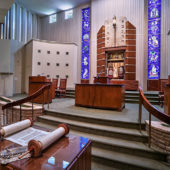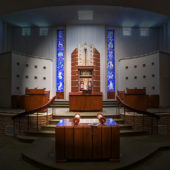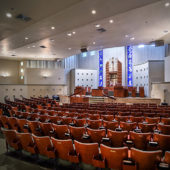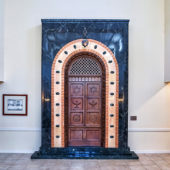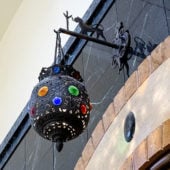One of the oldest Jewish institutions in Oklahoma and in a sense, the sole institutional survivor of the Varklan, Latvia shtetl.
Thank you to Congregation B’ai Emunah for furnishing the following:
Congregation B’nai Emunah: A Brief History Organized Jewish settlement in Oklahoma dates to the period before the Land Rush. By the 1870s, there was a functioning community in Ardmore, which built its first Synagogue in 1899. Tulsa’s Jewish community took root three years later, with the arrival of the first Jewish families in 1902. The Jews who came in the early days of settlement were overwhelmingly traditional and eagerly sought customary shape and form for their Jewish lives. These men and women were the founders of Congregation B’nai Emunah.
In one sense, the Tulsa pattern was a departure from the norm. The first congregations in the South and West were generally established by German Jews in the 1880s. Tulsa is notable for the prominence of immigrants from Eastern Europe, particularly Latvia. Many of Tulsa’s first Jewish families came from Varklan, a shtetl (small town) north of modern-day Daugavpils. Jewish settlement in Varklan ended on August 4, 1941, with the nazi extermination of its Jewish citizens. In a sense, the Synagogue is its sole institutional survivor.
It was out of this culture that B’nai Emunah emerged. Like immigrant Jews in every part of the world, the Jews of Tulsa first organized a minyan: a quorum for prayer and mutual support. By 1907, the number of Jews had swelled, in part because of the Galveston Project. Reacting to the nativist sentiment of the period, its organizers routed arriving immigrants away from the East Coast and toward the center of the country. Galveston became a second Ellis Island, and Jewish life in Oklahoma was strengthened as a result.
The congregation itself was officially organized on November 6, 1915. Within a year, members had their first building at the corner of Ninth and Cheyenne. Designed by prominent local architect John T. Blair, it reflected the deep traditionalism of its members: a women’s gallery separate from the seating area set aside for men, with a mikveh (ritual bath) in the basement of the building.
And yet despite these normative patterns, the first Rabbi of the congregation was an early graduate of the Jewish Theological Seminary of America, reflecting a more liberal attitude toward the tradition. Such tensions have been part of the history of the congregation, held in check by feelings of strong family cohesiveness.
The congregation left its first building in 1942 for a new facility at Peoria and Seventeenth Street. Over two decades of ongoing improvements, the congregation gradually reshaped its campus, giving itself room for a proper religious school, library, youth wing, and gymnasium.
Ultimately, the congregation set aside its improvisations and decided to build an additional facility on its site. The result was the Sanctuary Building of 1959. It resolved the problems of too-small worship spaces, inadequate kitchens, and a makeshift chapel. This space, too, was eventually improved with a 1985 addition that clarified the front entrance and created a new and usable reception area.
The Building Renewal Campaign that culminated in 2000 was rooted in all that came before it, taking many of its cues from the architecture of our first buildings. The 1942 building is gone, but the new facility sits on the original site and wraps itself around the core of the old Sanctuary Building of 1959. There is now one single structure to contain and define the efforts of the whole congregation.
As always with such undertakings, there were many creative people who had a hand in bringing the new building to completion. The congregation expresses gratitude to architect Alexander Gorlin of New York City, his staff, most especially to Glenn Goble for his exquisite draftsmanship and taste. Carolyn Fielder of Campbell Design in Tulsa was instrumental in shaping the final look of the building and continues to be involved in the choice of finishes and furnishings. Both were inspired by Alexander Gorlin’s original vision and helped translate it into a living and working building.
As the new century unfolds, we continue to experience transformation and renewal. We are building on a foundation of noteworthy stability. There have been just seven senior rabbis in the congregation’s history, a sign of close relationship between clergy and laity.

